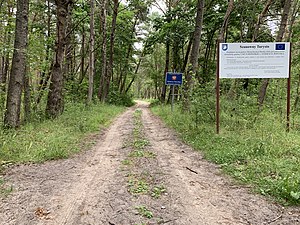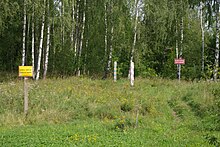Poland–Russia border
| Russia–Polish border | |
|---|---|
 | |
| Characteristics | |
| Entities | |
| Length | 206 km (128 mi),[1] 418 km (260 mi) or 416 km (258 mi) |
| History | |
| Established | December 1991 Dissolution of the Soviet Union |

The modern Poland–Russia border is a nearly straight-line division between the Republic of
History

The history of the border between Poland and Russia can be traced to the early history of both nations, with one of the earliest notable incidents being the Polish king
Modern border
The modern border between Poland and Russia is regulated by a number of legal documents, many of them dating to the times of the
While the actual border line remained unchanged following the
The Poland–Russia border is 232 km long between Poland and
The World War II ended in May 1945. The forming of the border began with huge restrictions on movement of civilians. The economic model typical of the USSR, reinforced by the dominant military role of the Kaliningrad Oblast, meant that it did not establish closer cooperation with the neighboring Polish areas (Olsztyn, Gdańsk and Białystok Voivodeships), and generally for a decade it played no role in the Polish-Soviet trade, economic and cultural contacts. East Prussia was divided by a kind of internal iron curtain. The lack of cooperation between both entities made it difficult to even deal with such basic matters as regulating the functioning of watercourses that crossed the border, for example the Łyna River. Only from time to time there were some Polish-Kaliningrad contacts, for example in November 1953, fish processing specialists from Gdynia met with colleagues from Kaliningrad and the three Baltic republics at a working conference in Riga. In turn, in 1954, the Soviet side became interested in navigation data regarding the water route from Kaliningrad to Elbląg and Gdańsk. However, this did not result in the launch of permanent cooperation.

The border began formulating in October and November 1945 when an artificial border was introduced, causing, among other things, eliminating some communication routes from use. The railway line

The lack of a formal demarcation of the border in the field, and it was the Army commandants and the

The official demarcation of the boundary was finalized March 5, 1957, in the following terms:
The Contracting Parties confirm that the existing State frontier between the
Zytkiejmy, 4 kilometres north of the inhabited locality of Gołdap, 0.5 kilometres south of the inhabited locality of Krylovo, 3 kilometres south of the inhabited locality of Zheleznodorozhny, 2 kilometres south of the inhabited locality of Bagrationovsk, 4 kilometres south of the inhabited locality of Mamonovo, 7 kilometres north of the inhabited locality of Braniewo (formerly Braunsberg) and thence across the Kaliningradsky Zaliv (Zalew Wislany) and the Baltiiskaya Kosa (Mierzeja Wislana) to a point on the west shore of this spit 3 kilometres north-east of the inhabited locality of Nowa Karczma (known as Piaski) and is part of the town of Krynica Morska (Föglers) (the distances between the inhabited localities and the frontier are approximate).[14]
In practice, the agreement was incomplete as it did not take into account the situation in many points where the border had to be rectified. During the work of the Delimitation Commission, the District National Council in Węgorzewo, and then the Provincial National Council in Olsztyn, suggested connecting a five-kilometer section of the road connecting pl:Ruskie Pola, located in Poland, with Kryłów, which belonged to the USSR, to the Polish People's Republic, as this section of the road was the only convenient connection of the village of Zielony Ostrów with the rest of the country. In return, the Polish side was ready to hand over to the Soviet side a similar section of the road connecting two towns on its side: Bogatowo and Korniewo. However, this proposal was not adopted by the Commission. However, other Polish proposals were taken into account: firstly, Poland was granted a relatively small area north of the town of Żytkiejmy, which enabled its inhabitants to farm, secondly, the Soviet Union agreed to give the Poland a one and a half kilometer section of the road connecting Szczurkowo with Ostre Bardo. The Polish side transferred, in the form of compensation, the crossroads in the area of the settlement of Mażucie, previously cut off by the border line, and also the Polish part of the lake near Bagrationovsk. The Delimitation Commission completed its work on September 10, 1957.[12]

When
As of 2008, there were three road crossings (Gołdap-Gusev, Bezledy-Bagrationovsk and Gronowo-Mamonovo) and three train crossing (Braniewo-Mamonovo, Skandawa-Zheleznodorozhny and Głomno-Bagrationovsk).[15][16][17] In 2010, the largest road crossing up to that point was opened at Grzechotki-Mamonovo.[18] More crossings are being built (Perły-Krylovo, Piaski-Baltiysk, Rapa-Ozyorsk), as the EU standards require Poland to operate at least seven for that border.[15]
In the first quarter of 2012, the Polish-Russian border saw the least traffic out of the borders Poland shares with the non-
On November 2, 2022, Poland's Minister of National Defence Mariusz Błaszczak announces the construction of a barrier along the border with the Russian exclave of Kaliningrad, as Poland believes that Russia will use the border to illegally transport African and Asian immigrants to Europe.[20][21][22][23] This barrier is planned to reach 3 metres (9.8 ft) high, and include cameras and motion detectors. The move to construct the barrier came in response to Kaliningrad allowing from 1 October for a far greater level of international flights to its airport.[24]
Border area
Because Kaliningrad Oblast is small, homogeneous and an exclave within the European Union, in 2011 the whole Oblast was granted the status of border area eligible to local border traffic rules. In reciprocity, the following Polish administrative districts (powiaty) were granted the same status:[25]
- in the Nowy Dwór Gdański, Malbork
- in the
The border traffic is very high, and additional border crossings are being considered as of 2013.[26][needs update] Due to worsened relations between Poland and Russia after the annexation of Crimea these plans came mostly to a halt.
Border crossings
See also
- Curzon Line
- Poland–Russia relations
- Polish–Russian Wars
- Enclave and exclave
References
- ^ Rocznik Statystyczny Rzeczypospolitej Polskiej 2019. Warszawa: Główny Urząd Statystyczny, 2019, s. 80. ISSN 1506-0632.
- ^ Wyprawa Kijowska Chrobrego Chwała Oręża Polskiego Nr 2. Rzeczpospolita and Mówią Wieki. Primary author Rafał Jaworski. 5 August 2006 (in Polish)
- ISBN 978-1-57607-800-6. Retrieved 12 September 2012.
- ISBN 978-0-253-34588-2. Retrieved 12 September 2012.
- ^ "Ryski traktat pokojowy - WIEM, darmowa encyklopedia". Portalwiedzy.onet.pl. Retrieved 2012-09-12.
- ^ Polska w cyfrach[permanent dead link] [in:] E. Romer Atlas Polski wspolczesnej, 1928[permanent dead link]
- ^ a b c d Tomasz Dubowski. Chapter Granica polsko–rosyjska jako granica zewnętrzna Unii Europejskiej. In PRZYJAZNA GRANICA NIEZBĘDNYM ELEMENTEM WZMACNIANIA STOSUNKÓW SPOŁECZEŃSTW POLSKI I ROSJI, Wydział Prawa Uniwersytetu w Białymstoku, 2011. Accessed on 11 September 2012. [1] Archived 2018-07-28 at the Wayback Machine
- ISBN 978-83-87251-71-0. Retrieved 12 September 2012.
- ^ a b Janusz Szymańskii. Chapter Relacje traktatowe z Rosją po przystąpieniu Polski do UE. In PRZYJAZNA GRANICA NIEZBĘDNYM ELEMENTEM WZMACNIANIA STOSUNKÓW SPOŁECZEŃSTW POLSKI I ROSJI, Wydział Prawa Uniwersytetu w Białymstoku, 2011. Accessed on 11 September 2012. [2] Archived 2018-07-28 at the Wayback Machine
- ^ "Pedestrian border crossing, Krzysztof Mrozek p. 2" (PDF).
- ^ a b c Mały Rocznik Statystyczny Polski 2012, Główny Urząd Statystyczny, 2012. Accessed on 11 September 2012. [3]
- ^ a b c Mirosław Golon. "Problem polsko-radzieckiej granicy w byłych Prusach Wschodnich w latach 1945-1958" (in Polish). Retrieved 2023-09-27.
- ^ Wojciech Rojek. sowieckiej_rosyjskiej_polnocnej_granicy_panstwowej_1957-2009_2014.pdf?sequence=1&isAllowed=y "Delimitacja polsko-sowieckiej/rosyjskiej północnej granicy państwowej 1957-2009" (PDF). Jagiellonian University. Retrieved 2023-09-27.
{{cite web}}: Check|url=value (help) - ^ Russia (USSR) / Poland Treaty (with annexed maps) concerning the Demarcation of the Existing Soviet-Polish State Frontier in the Sector Adjoining the Baltic Sea 5 March 1957 (retrieved from the UN Delimitation Treaties Infobase, accessed on 18/03/2002)
- ^ a b "Powstanie nowe przejście z obwodem kaliningradzkim. wnp.pl | Serwis Logistyka. Transport, logistyka, firmy kurierskie". Logistyka.wnp.pl. 2008-04-16. Retrieved 2012-09-12.
- ^ "Straż Graniczna - Treść" (in Polish). Strazgraniczna.pl. 2008-05-13. Retrieved 2012-09-12.
- ^ "Straż Graniczna - Treść" (in Polish). Strazgraniczna.pl. 2008-05-13. Retrieved 2012-09-12.
- ^ Agencja Reklamowa GABO (2010-12-08). "W Grzechotkach ruszyło największe przejście na granicy z Rosją". info.elblag.pl. Retrieved 2012-09-12.
- ^ a b c Badanie obrotu towarów i usług na zewnętrznej granicy Unii Europejskiej na terenie Polski w I kwartale 2012 roku, GŁÓWNY URZĄD STATYSTYCZNY URZĄD STATYSTYCZNY W RZESZOWIE, Warszawa-Rzeszów, 23 maja 2012 r.. Accessed 11 September 2011. [4].
- ^ "Poland lays razor wire on border with Russia's Kaliningrad". AP NEWS. November 2, 2022.
- ^ "Poland Orders Border Wall With Russia's Kaliningrad, Cites Security and Migrant Crossings". Time. 2022-11-02. Archived from the original on 2022-11-15.
- ^ "Poland to build wall on border with Russia's Kaliningrad – DW – 11/02/2022". dw.com.
- ^ "Poland lays razor wire on border with Russia's Kaliningrad". ABC News.
- ^ Claudia Ciobanu (November 15, 2022). "Fog of War Thickens on Poland-Russia Border at Kaliningrad". Balkan Insight. Retrieved November 21, 2022.
- ^ "EUR-Lex - 32011R1342 - EN - EUR-Lex". eur-lex.europa.eu.
- ^ Eastern approaches Ex-communist Europe (2013-10-08). "Poland and Kaliningrad: Small Border Traffic". The Economist. Retrieved 2013-10-18.
- ^ a b c d See Google Maps for respectively coordinate and OpenStreetMap.
- ^ See Google Street View for respectively coordinate.
